Van Gogh Museum Journal 2001
(2001)– [tijdschrift] Van Gogh Museum Journal–
[pagina 84]
| |
 fig. 1
Fréderic Bazille, The artist's studio, rue de la Condamine, 1870, Paris, Musée d'Orsay | |
[pagina 85]
| |
‘Avant et après’ - Paul Gauguin and Vincent van Gogh in Arles: projections of a friendship
| |
[pagina 86]
| |
two such beings - the one a perfect volcano, the other bolling, too, but inwardly - a kind of battle was in preparation.’Ga naar voetnoot4 Underlying Gauguin's description is a logic that proceeds from the premise of insurmountable incompatibility and concludes with the inevitability of Van Gogh's self-disfigurement. Gauguin also includes further ‘details’ in his narrative: how Van Gogh threw an absinthe glass at him; followed and threatened him with an open razor; returned, on his own, to the Yellow House; mutilated himself and then deposited his severed earlobe at the brothel the two artists generally frequented, whereupon Gauguin left Arles without Van Gogh's ever seeing him again. The sequence of events as set out in the Intimate journals has been repeated in a great many different works. The early monographs on both Van Gogh and Gauguin - from Curt Glaser (1921) through Julius Meier-Graefe (1922) to Carl Sternheim (1924) - describe the incidents in this order, as do the biographical novels of Beril Becker (1931), Irving Stone (1934), Lee van Dovski (1947), Lawrence and Elisabeth Hanson (1954) and Erich Landgrebe (1959). Feature films such as Lust for life by Vincente Minelli (1956) and Vincent and Theo by Robert Altman (1990), finally, cemented the episode into the foundations of the myths that now surround the two artists.Ga naar voetnoot5 Arles, the period of companionship, has been transformed into ‘drama.’Ga naar voetnoot6 | |
II.Thus it is that the view of the personal and aesthetic differences between Gauguin and Van Gogh presented in the Intimate journals has left its mark on the conception of the two artists both in popular culture and in art history. This view, however, is not just one-sided - based on the standpoint of only one of the two persons concerned - but belated as well, for it was not formulated until several years after the events described.Ga naar voetnoot7 That this source should have had such an overriding power may be ascribed to the fact that the most essential contemporary sources of information for research on Van Gogh, namely his letters to his brother Theo, provide almost no information on those few crucial weeks in Arles. Thus, Gauguin's memoirs - irrespective of the time that had elapsed between the events and his account of them - are our only ‘eyewitness report.’ Indeed, they have acquired the status of historical documents despite the fact that by the time of their appearance the naturalisation of the painters' friendship - i.e. the transformation of their history into myth - had already taken place. For whilst the retrospective picture Gauguin created of his relationship with Van Gogh derives from ideas the artists had of one another and their communal life in Arles, it nevertheless alters their meaning. At the beginning of their relationship, the prevailing notion was one of an artists' community, which was neither limited to Van Gogh and Gauguin nor based on any kind of fateful attraction between them. Van Gogh's notion of a ‘studio of the south’ instead stemmed from the wish to organise like-minded artists for purely economic reasons. Working and living together could, for example, serve to reduce everyday expenses. Above all, however, the aim of such a community would be to channel the activities of its members for the financial benefit of everyone involved: relatively well-known and less well-known painters could, through the sale of their comparatively expensive works, help provide the upkeep of those who were just starting out. Theo van Gogh, who was to handle the business side | |
[pagina 87]
| |
of things, was to have overall control of the enterprise. Indeed, whenever the correspondence between Van Gogh, his brother, Gauguin and Emile Bernard refers to the planned artists' community in Arles (or in Pont Aven), its gist was always the same, stressing the economic advantages of working together.Ga naar voetnoot8 Van Gogh's idea took on concrete form when he asked Theo to support him and Gauguin in Arles, in exchange for the latter's paintings.Ga naar voetnoot9 Although Gauguin was open to the suggestion it was only after considerable hesitation that he left for the south, a decision motivated more by his own financial difficulties than by anything else. Whereas in Pont Aven he was unable to pay his rent, his doctor's fees and his travel expenses, the move to Arles would mean freedom from debt and, at least temporarily, a guaranteed income.Ga naar voetnoot10 Quite apart from that, however, he himself had reflected on the economic benefits of such joint ventures, although his own ideas to this end revolved instead around finding collectors who were interested in investing in an art fund comprising the work of younger artists.Ga naar voetnoot11 Both these pragmatic approaches to artistic collaboration reflect the situation of the moment and the structural changes that had taken place in the art world during the 19th century. In this context Cynthia and Harrison White have spoken of the evolution of the ‘dealer-critic system,’ which grew in direct proportion to the loss of power of the aristocracy (as the traditional buyers of art) and the academies (as the guardian both of the procedure of admission to the profession and of the production, presentation and distribution of works of art).Ga naar voetnoot12 Among the concomitant results of these institutional changes were independent one-man and group exhibitions mounted on private initiative; the transformation of the artist's studio - hitherto considered a private place - into a public salesroom;Ga naar voetnoot13 and the association of artists who saw themselves united by common aesthetic convictions, artists who were not infrequently supported and encouraged by critics, patrons and dealers of similar persuasions. The initiative taken by the impressionists exemplifies this new strategy for success: these artists came together for the express purpose of mounting a joint exhibition that would attract and organise a public favourable to their aims.Ga naar voetnoot14 On the one hand, it was to differentiate them from the prevailing standards of art and its institutional structures; on the other, it directed the attention of potential buyers and viewers to the specific characteristics of their own art. Moreover, in gathering a circle of initiates around charismatic, out-of-the-ordinary personalities, the show created the necessary prerequisites for the dissemination of their very impact and fame.Ga naar voetnoot15 The exclusivity of such circles, the separation of the initiated from the uninitiated, is the mainspring of the mechanism. The conflicts concerning admission to the group exhibitionsGa naar voetnoot16 had their roots not just in aesthetic differences but also in the strategic desire to create a new, unified and easily recognisable direction in art. Frédéric Bazille's painting The artist's studio, rue de la Condamine (fig. 1) is the perfect illustration of this channelling of interests towards exclusivity: hanging on the walls of the studio, as if in a public exhibition, are Bazille's own works and those of his colleagues, while other accessories, - the piano, for example - denote the private nature of the space. Privacy is also suggested by the small number of people present, these being, without exception, the artist's closefriends.Ga naar voetnoot17 In conveying the idea of access | |
[pagina 88]
| |
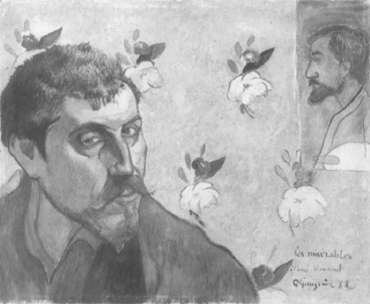 fig. 2
Paul Gauguin, Self-portrait (‘Les misérables’), 1888, Amsterdam, Van Gogh Museum (Vincent van Gogh Foundation) granted only to the ‘initiated,’ Bazille's painting clearly seeks to attract attention to the art of the impressionists. One might see in this a parallel model for the kind of association sought by Van Gogh and Gauguin: a small circle of like-minded artists whose work was publicised and offered for sale by an agent - not by Frédéric Bazille and not by Paul Durand-Ruel, the most important impressionist dealer, but by Theo van Gogh, the trusted spokesman of the younger generation.Ga naar voetnoot18 Closely bound up with such reflections on the socioeconomic structures of the art world during the closing years of the 19th century are Van Gogh's and Gauguin's own notions about the life of the artist. However, although these ideas were ultimately derived from these self-same structures, they had already been de-historicised and mythologised. The sign, as Roland Barthes puts it, had become the signifier, the historical had been transformed into the natural, entering into the realm of connotation, of second-order signification, and hence of myth.Ga naar voetnoot19 Myth and history merge, for example, when Van Gogh writes of illness as an integral part of the life of the artist.Ga naar voetnoot20 He sees himself | |
[pagina 89]
| |
as a permanent sufferer and characterises Gauguin's life similarly. Both of them, he writes, are poor, starving and - he more than all others - lonely.Ga naar voetnoot21 This highly individual state of mind and body is seen by both Van Gogh and Gauguin as symbolic: suffering and loneliness are the passport to the world of the artist. While illness had been a topos of the myth of the artist since the Renaissance, loneliness and poverty are notions notably associated with the modern-day creator, a consequence of his exclusion from bourgeois society, which, in turn, results from the failure of that society to recognise his (often highly unconventional) personal and artistic qualities.Ga naar voetnoot22 The ‘studio of the south’ was to provide a cure for suffering, illness, poverty and lonliness.Ga naar voetnoot23 Rather than a strategically conceived, outgoing and publicly oriented understanding of the artists' association it follows an inward-looking concept of community, its primary aim to provide consolidation and consolation, and to relieve pain. As an antidote to a malicious, ungrateful society, it would give shelter to the (still) unknown artist, becoming a place of refuge for the ‘troglodytes,’ those who suffer from a lack of understanding by their fellow human beings.Ga naar voetnoot24 It was to be a community of artists that offered its members a substitute for the social recognition they had previously been denied. The pictures that Gauguin and Van Gogh painted with the other in mind give visual form to these notions of the artist. No matter with whom they identified - whether Jean Valjean, the outlaw in Victor Hugo's Les misérables (fig. 2),Ga naar voetnoot25 the poet (fig. 3)Ga naar voetnoot26 or the Buddhist monk (fig. 4)Ga naar voetnoot27 - all, without exception, were outsiders. Crime, dream, religion - all were areas that defied or counteracted social norms and legislation. Exclusion from bourgeois society, the mark of the artist throughout the 19th century - as seen in self-portraits, studio depictions and paintings of precisely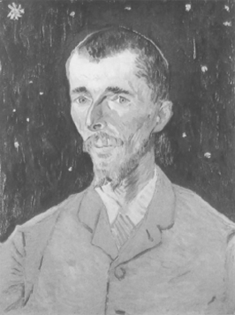 fig. 3
Vincent van Gogh, Portrait of Eugéne Boch (Le poète) (F 462 JH 1574), 1888, Paris, Musée d'Orsay those poets whom Van Gogh envisaged for his series of the Poet's garden - is central to Van Gogh's and Gauguin's perception of both themselves and each other prior to their time in Arles. In requesting Gauguin become the head - the abbot - of a community of artists, Van Gogh conveys the clear message that being beyond the pale also offers opportunities | |
[pagina 90]
| |
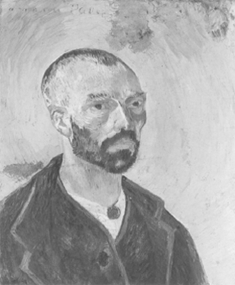 fig. 4
Vincent van Gogh, Self-portrait (F 476 JH 1581), 1888, Cambridge MA, Fogg Art Museum, Grenville L. Winthrop Bequest for the artist.Ga naar voetnoot28 Thus, in a fusion of mythical and real perceptions of the life of the artist, the ‘studio of the south’ became a social alternative with its own hierarchical structures, laws and values. | |
III.Given the prominence the Arles episode has enjoyed in the 20th-century reception of both artists, one might suppose that the first articles on Gauguin and Van Gogh to be published after 1888, as well as those that appeared throughout the 1890s, would contain numerous references to this period. Quite the contrary: neither the objectives of their cooperation nor the events in Arles, nor even their personal relationship, were of much interest. Instead, most attention was paid to Van Gogh's concept of an artists' community - although now it was discussed not in conjunction with any definite names but rather, in a more extended sense, roughly along the lines of a yearning à la Gauguin for a life beyond Europe and civilisation. The notion of a social alternative here becomes closely bound up with the hope of discovering completely new areas of aesthetic expression beyond the shores of France and the restrictions of French society. Such associations played a role whenever Van Gogh's plans for a ‘studio of the south’ were considered. That the first-ever attempt to found such a community had been a complete failure was ignored by the critics.Ga naar voetnoot29 In keeping with this emphasis, the reviews made no attempt to proffer a picture of the artists' friendship either. Only their significance for contemporary art - for symbolism and for neo-traditionalism as defined by Maurice Denis - was noted, and it was this significance alone that warranted the joining of their names.Ga naar voetnoot30 In fact, instead of underscoring their friendship, writers soon took to stressing the differences between the two artists' characters. While in Van Gogh's case it was his childlike naiveté, exuberance, excess and lack of control that found mention (and even gave rise to speculation about his sanity), Gauguin's critics continued to characterise him as uncivilised and primitive - as they had done ever since his first voyage to the South Seas in 1891.Ga naar voetnoot31 Viewed together, these characterisations may, however, be regarded as different aspects of one and the same idea, namely that of the artist as a social outcast seeking refuge in either the inner or outer worlds. The first of Albert Aurier's series of articles, written with the aim of validating the symbolist movement, was entitled ‘Les isolés’ and bears exemplary witness to this idea. | |
[pagina 91]
| |
Aurier's monographic studies of both Van Gogh and of Gauguin underline their exclusion from contemporary society, pointing an accusing finger at the bourgeoisie and assuring that things would look very different in the future: ‘[...] connaîtra-t-il un jour - tout est possible - les joies de la réhabilitation, les cajoleries repenties de la vogue?’ he asks at the end of his piece on Van Gogh. Similarly Aurier concludes his manifesto-like Le symbolisme en peinture, for which Gauguin served as his model, by accusing his contemporaries of ignorance, ending with the appeal: ‘[...] des murs! Des murs! Donnez-lui des murs!’Ga naar voetnoot32 Social alienation and lack of recognition here go hand-in-hand - a motif that was already a part of the myth of the modern artist in the 19th century and which has since become thoroughly engrained in the legends surrounding Van Gogh and Gauguin.Ga naar voetnoot33 | |
IV.The mythologemes just mentioned are not, however, the ones at work in Gauguin's 1903 account of those few weeks in Arles. His description instead evidences a change of perspective, instigating a paradigm that would henceforth characterise the two artists more in relation to one another other. The decisive passage, at least as far as the discussion of their aesthetics is concerned, is the one in which Gauguin claims responsibility for having persuaded Van Gogh to drop neo-impressionism in favour of a kind of painting more suited his temperament. It was from this moment on, Gauguin alleges, that his friend began to make progress, ‘and the result was that whole series of sun-effects over sun-effects in full sunlight.’Ga naar voetnoot34 While Gauguin insists his ‘enlightening’ advice influenced the younger painter, he simultaneously stresses that it had not led to Van Gogh forfeiting any of his originality.Ga naar voetnoot35 In the final analysis, however, this description of the differences in their approaches to art serves primarily to distinguish between their personalities, for Gauguin hints at a relationship of power, which, in one form or another and to a greater or lesser extent, informs his entire account. In this relationship, an equal exchange between the two artists was impossible; rather, Van Gogh could ‘repay’ Gauguin only by recognising him as his teacher: ‘When I arrived at Arles, Vincent was trying to find himself, while I, who was a good deal older, was a mature man. But I owe something to Vincent, and that is, in the consciousness of having been useful to him, the confirmation of my own original ideas about painting.’Ga naar voetnoot36 Gauguin played a similar role in regard to Van Gogh's untidiness in what seemed to be every sphere of his life and work: ‘In the first place, everywhere and in everything I found a disorder that shocked me.’Ga naar voetnoot37 The chaos began in Van Gogh's paint box and spread from there to the way he cooked, the way he handled his money, how he painted and the way he thought. Just as he took over the management of their joint finances and began to cook for them both, Gauguin also endeavoured ‘to disentangle from this disordered brain a reasoned logic in his critical opinions.’Ga naar voetnoot38 Making no mention of the financial motivation behind his decision to leave Pont Aven, Gauguin instead stresses how long he resisted Van Gogh's urging him to come to Arles. This steadfastness has its parallel in Gauguin's physical strength, which, he feared, might lead him to strangle Van Gogh the next time the latter attacked him. The physical superiority is underlined in his contrasting reference to Van Gogh's ‘well-known step, short, quick, irregular.’Ga naar voetnoot39 It corresponds not only with the role Gauguin intended for himself as the ‘director’ of the planned artists' communityGa naar voetnoot40 but also, and primarily, with the trial of strength that took place during their very last encounter. Gauguin's description of this scene consecrates once and for all the fundamental differences between the | |
[pagina 92]
| |
two artists: ‘My look at that moment must have had great power in it, for he stopped and, lowering his head, set off running towards home.’Ga naar voetnoot41 Gauguin's powerful gaze wards off Van Gogh's armed attack, forcing the latter not merely to stop in his tracks but, after a gesture of submission, to beat a retreat. Later, at the bedside of the unconscious Van Gogh, this dreadful gaze metamorphoses into the dreadfulness of the sight of Gauguin himself, the affect of which might well have been ‘fatal’ for the younger artist.Ga naar voetnoot42 Van Gogh's addressing Gauguin as ‘Master’ in his last letter to him completes the picture Gauguin paints of his friend's subordination.Ga naar voetnoot43 There are two ways in which Gauguin's narrative transforms what had hitherto been the defining aspects in the reception of the two artists: in the first place, it shifts the accent away from the artists Van Gogh and Gauguin towards the human beings Vincent and Paul. Nathalie Heinich describes this accentual relocation as an essential step in the formation of a legend and the glorification of the artist, for it crystallises ‘the general process of folding artistic excellence into religious forms of greatness.’Ga naar voetnoot44 Secondly, Gauguin's account gives us a picture of two human beings linked by fate. Whereas in the 1890s phrases such as ‘eccentric and mad’ and ‘uncivilised and primitive’ were used by art critics to characterise and differentiate Van Gogh and Gauguin's respective qualities, Gauguin's chronicle evokes a relationship in which the two artists are so closely bound up with each other that the personality and behaviour of the one can henceforth be defined only in relation to the personality and behaviour of the other. The two artists have now become the symbolic embodiment of pairs of opposites within a social frame of reference: outgoing enthusiasm is yoked with calculating reserve; the readiness to receive with the generosity of giving; the insecure search with the self-assurance of the initiated; intuitive chaos with intellectually controlled order; altruism with egocentricity; subjugation with commanding power. Gauguin's account thus makes an important addition to the images previously developed of what linked these two artists together. To the pragmatic idea of joining forces with the aim of achieving greater exposure, a more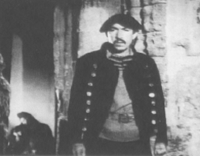 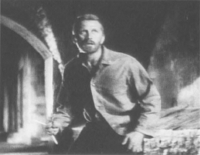 fig. 5
Still from Vincente Minelli's, Lust for life, 1955 intensive exchange and, last but not least, financial security, and also to the underlying associations with the existing myth of the artist as social outcast, Gauguin now adds the description of a binding tie between two very different, even incompatible, personalities. It is precisely the latter that qualifies their relationship as more than one of mere coexistence but actually as a ‘friendship’ in the sense of Michel de Montaigne. In his definition, friendship is about the ‘harmonisation of two wills’ and the ‘fusion’ of two souls. Its opposite is the state of marriage which, according to Montaigne, is ‘a deal serving ordinary purposes that have nothing to do with friendship. [...] With friendship, on the other hand, there is no bargaining or dealing, it is concerned | |
[pagina 93]
| |
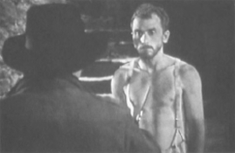 fig. 6
Still from Robert Altman's Vincent and Theo, 1990 solely with itself.’Ga naar voetnoot45 Implicit in this idea is that friendship ranks higher than civic duties, that loyalty to one another can override all the other laws governing society.Ga naar voetnoot46 Friendship thus has the potential for effecting change; it can offer an alternative to existing communal structures - an alternative that can just as much result from changed norms and values as it can constitute new ones. | |
V.Which norms and values were embodied in Gauguin's account of the friendship is a question that cannot solely be answered in aesthetic terms. The artists' debates on symbolism and its departure from both realistic depictions of nature and neo-impressionism only constitute a minor battlefield in the clash of forces Gauguin describes. As presented in his writings, their differences, rather, were akin to those one would conventionally associate with a love affair between members of the opposite sex, with gender-specific behavioural patterns: the one soft, submissive, illogically intuitive and receptive; the other physically superior, self-assured, confident of his intellect and dominant. What Gauguin only implies becomes in the accounts that follow the main cause of their quarrels. The aesthetic dispute is here replaced by a battle of the sexes - and with clearly erotic undertones. The most explicit expression of this can be found in Carl Sternheim, who compares Van Gogh's waiting for Gauguin to a ‘fever of lascivious longing’ in which, for example, he would yearningly dash off a few lines to Gauguin and then run off to the brothel. The months in Arles only heightened the tension: ‘They played cat and mouse with each other, like a man and a girl at the moment when cheeks are flushed and defloration is nigh.’ In this scenario Van Gogh's resort to the razor becomes an impulsive act of revenge, directed not least against the satisfaction Gauguin derives from his visits to the prostitutes.Ga naar voetnoot47 The conception of Gauguin as a successful womaniser - both here and in Beril Becker's later biography - automatically casts Van Gogh in the role of the woman who gives herself to her seducer.Ga naar voetnoot48 Van Dovski modifies this notion slightly, turning the seduction into a marital confrontation and likening the ups and downs in Arles to those of a marriage. Gauguin's wish to return to Paris leads to a ‘marriage drama’ in which Van Gogh, weeping, implores him to stay. The actual trigger of the crisis was Gauguin's behaviour in the brothel.Ga naar voetnoot49 These two narrative elements are also linked in Vincente Minelli's film version of Irving Stone's novel Lust for life, the most famous biographical novel about Van Gogh. The tension that has been mounting between the two artists reaches its climax in the scene in which Gauguin's imperious gaze forces Van Gogh, cowering before him, to leave (fig. 5). In Robert Altman's Vincent and Theo the moment has explicitly sexual connotations, for Gauguin draws a dagger on the now scantily clad Van Gogh and taps it against his chest, touching him and yet at the same time keeping him at a distance (fig. 6). In Altman's film this is an unambiguously homoerotic incident: Van Gogh kisses Gauguin passionately and the latter pushes him away, thus provoking the events that follow. | |
VI.Gauguin's account forms the backdrop for all these representations. It provides the stimulus for their embellished, sexualised fictionalisations. It is the source of the clichés around which all these tales have been woven. Decisive for the lasting impact of Gauguin's memoirs is their extraordinary abundance of anecdotes. Indeed, it is to this abundance that Avant et après owes its credibility. As Catherine M. Soussloff points out, the anecdote in its original sense - i.e. a private, unpublished narrative - always has something of the revelation about it. It lends ‘realism’ | |
[pagina 94]
| |
to what in fact has been imagined. The continual repetition of an anecdote, for example in history books, creates the illusion of authority - not least thanks to the reference to all the other authors who have quoted it in the past - in spite of the fact that the image it conveys actually precedes the historical events.Ga naar voetnoot50 The decisive image in Gauguin's Intimate journals, in which notions of the modern artist are reproduced in mythologised form, is that of the friendship between himself and Van Gogh. This image adds to the notions ‘primitive’ and ‘mad’ (that mirror the status of the two artists as social outcasts) features more specifically bound up with the internal, structural changes taking place in modernism. These are expressed in the tense ‘duality of togetherness and irreplaceable uniqueness’ which, according to Klaus-Dieter Eichler, distinguishes friendship.Ga naar voetnoot51 Gauguin and Van Gogh share their fate as outcasts just as they shared an initial artistic leaning towards impressionism and a subsequent break with it. They differ, on the other hand, both in regard to the personal characteristics that resulted in their social exile and in the way they broke with their former styles. The friendship motif becomes a kind of pillar, a pillar supported equally by what separates and unites them, and which also assumes a supporting function in itself. In this sense the artists' references to one another, their mutual respect and subsequent separation as depicted by Gauguin exemplify - in a condensed form - the strategies Griselda Pollock has described as ‘avant-garde gambits’ or: ‘the play of reference, deference and difference.’ This is a playful technique of self-positioning within the art field: first referring to what is currently happening in the avant-garde, then showing deference to the movement's current leading figure, and finally differentiating oneself from the latter once and for all.Ga naar voetnoot52 Gauguin describes Van Gogh's development along just such lines: it was, he writes, Meissonier, Monticelli and the neo-impressionists - at the time among the most discussed painters - to whom Van Gogh initially related, showing them, and him, Gauguin, the greatest respect.Ga naar voetnoot53 The fact that Van Gogh was nevertheless able to break away from them and to discover his own, original style was the decisive point as far as Gauguin was concerned. Even though he claims to have been responsible for some of the steps taken by Van Gogh, he simultaneously stresses the younger painter's continuing originality.Ga naar voetnoot54 Here Gauguin calls upon Albert Aurier as his witness. Aurier had published the first detailed monographic articles on Gauguin and Van Gogh in 1890/91, drawing attention to the differences in their respective symbolist approaches and it was to Aurier, Gauguin writes, that Van Gogh had confessed to the latter's influence upon him.Ga naar voetnoot55 Van Gogh's artistic uniqueness, which in Gauguin's account of their friendship is closely bound up with the notion of their togetherness, was proof that both of them belonged to the avant-garde. In his memoirs as in his art, Gauguin implements strategies of self-assertion that take into account modernism's changing demands on the artist. In his version of his relationship with Van Gogh, these strategies operate on the level of the artist's personality or image, for, in the final analysis, the culmination of their relationship in a battle of the sexes reflects nothing other than the contradictory image of the modern artist. On the one hand, we have the notion of the self-absorbed - male - artist, full of inexhaustible creativity and productive urges, subjugating material to his will; on the other, a concept of the artist more in keeping with the art field's changed structures of presentation and sale, an artist who - in a role with feminine connotations - exposes himself, offers himself to the public's gaze and invites attention. The autonomous, virile artistic approach of the one - which lost none of its attraction during the 20th century - is enfolded in the coquettish posing in the spectator's view. In the symbolic usage of the biographical anecdote Gauguin and Van Gogh are made out as representatives of these two aspects respectively. While they are independent and individual artistically, as required by the tenets of the avant-garde, when taken together they embody the contradictory personal qualities ascribed to the modern artist in general. Their characteristics stand in for the various ways the artist and society have interacted since the beginnings of modernism. The relationship between the two artists, which Gauguin is so keen to describe in his retrospective account of 1903, reconciles these opposites in a composite picture. Considering their relationship as described in the Intimate journals and its subsequent life in film and fiction, neither Van Gogh nor Gauguin emerges from the Arles conflict as the winner in the struggle for a new kind of art.Ga naar voetnoot56 Rather we see that both are integral parts of the image of the modern artist. It is in their personal relationship that a certain self-assertion strategy becomes manifest af- | |
[pagina 95]
| |
ter all; not the economic and social one envisaged by Van Gogh and Gauguin prior to 1888, but rather a discursive one, one which, despite - or even because of - their differences has in the course of the 20th century made both of these two men into paradigms of the modern artist. |
|

